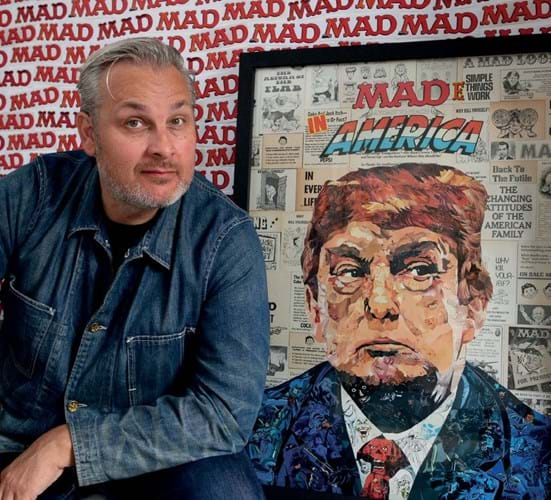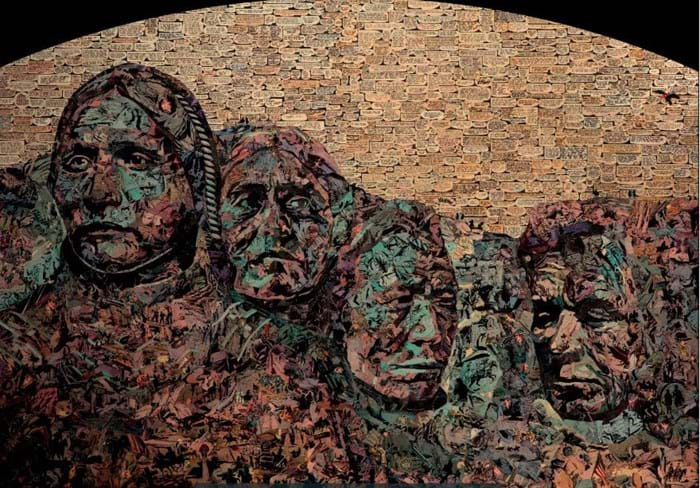Artist Ben Turnbull creates large-scale collages using cut-outs from vintage US comics. His recent show at Bermondsey Project Space, American History X volume III, Manifest Decimation followed on from an exhibition at the Saatchi Gallery in 2017. However, he also collects some of the material he uses in his works. Here he talks to ATG about how he uses vintage comics and when to save them.
ATG: How did you start collecting comics?
Ben Turnbull: I’ve always collected, and comics were part of my hunter-gatherer obsession. I was heavily into The Man from Uncle among other cult TV shows, so I used to hunt memorabilia based on these types of programmes. I’d trawl through stalls at Camden Market or Books, Bits n Bobs, a great old shop in Kingston.
Then when the collection became part of my job description, I’d hit all the car boot sales I could.
I used to bump into Peter Blake at the Chiswick one quite a bit, and it got competitive as we hunted out particular pieces of the puzzle for our works. I remember frantically getting in ahead of him for my GI Joe action men for the piece Homecoming, a life-size coffin made from these figures.
What is your focus?
Late 1950s to late 1970s comics. The style of branding and colouring somehow fits with the stories I want to tell in my work. I guess it’s based on corrupting or subverting these very innocent objects from more pleasant times.
I’ve branched out into merchandise as the projects have become more expansive. I found a couple of DC comic neon signs in Brooklyn which I incorporated into the Supermen series concerning the 911 firefighters. For my current show I spent around four months collecting original ‘cowboy and Indian’ figures (mainly 50s and early 60s).
How do you balance your collage making with your identity as a collector?
It does mean making a sacrifice, but it used to bug me when I saw people making collages out of works without really preserving the pieces. Every piece I cut ends up behind museum-quality glass and can’t be peeled away. In some collectors’ eyes it might be destructive, but I can look at it and pick out, for example, the joker from Batman: The Killing Joke or a Jack Kirby cover.
How many do you keep pristine?
For every 12 issues I acquire there’s probably one where I think “I’m never touching that”. It’s a tricky situation and I do make sacrifices.
Once I cut a Frank Miller Daredevil issue and that kind of broke my heart, but then I found another one in even better nick. I’ve used it once and won’t use it again.
I have around 400 set aside. I also keep every one that I cut into in crates in the studio. There are about 5000 of those issues.
There is also my pride-and-joy shelf in a totally different area of the house.
Most treasured is my Hubert Selby Jr collection of signed first editions (Requiem for a Dream, Last Exit to Brooklyn, The Room). It has my signed first edition of Wanderers, for example, and the whole series of EC Horror Library – Tales from the Crypt, Vault of Horror and The Haunt of Fear.
Where do you source your material?
These days I buy from specific dealers in the US because they offer such good value – they have batches of 25 or 30 each for about $60.
When you are creating your works, how do you choose what to buy?
The project decides the medium. The right combination usually appears through books and research.
There are often times when I have to buy a batch of material to understand the colours and the papers – all comics have a very different physical feel.
While working on the show for the Saatchi, I found some incredible war comics which gave me some of the most amazing artwork, from Sgt Rock to Weird War Tales. Those colours and textures just don’t get used any more.
Do you think what you are doing shocks other collectors?
Yes, if I were trashing an Action Comics 1 (the first appearance of Superman) I’d be making a real statement – you’d really need to have an ulterior motive to do that.
Other collectors might appreciate that I’m not cutting up these lesser-known works for the sake of it, but to create something with them and do some preservation in the process.
In most cases, there are so many copies of each comic. I read every copy I handle. For me there’s nothing more exciting than getting a new batch and looking through them, seeing how the artwork developed over 75 years.
Do other collectors read them? They might just be looking at the cover to see if there’s any browning.
What’s your advice to budding collectors?
Do realise what you’re letting yourself in for: always moving boxes around, your entire existence with your nose in musty books or dusty basements of comic shops.
















